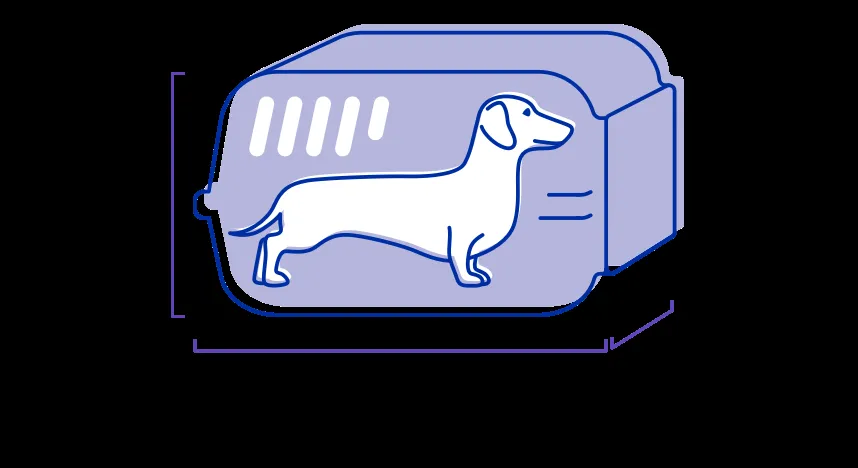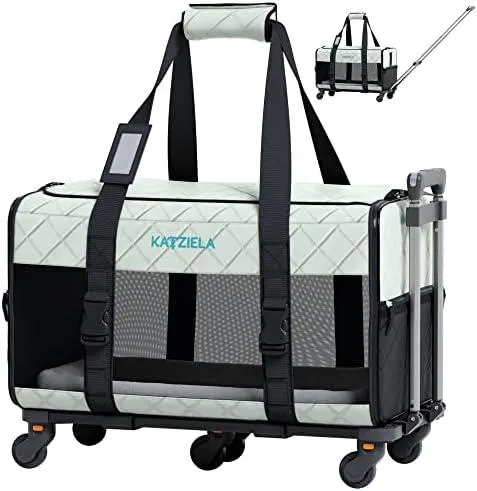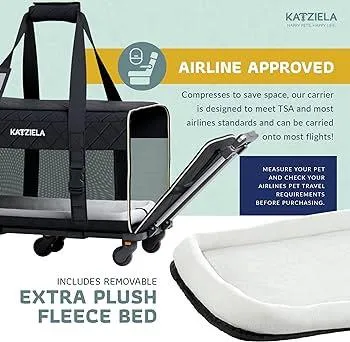Getting Your Dog on a Plane: What Size Dog Can Fly in the Cabin?
As an avid traveler with my dog Duke, one of the most common questions I get is “What size dog can I bring on the plane?” If you want to take your furry companion flying with you in the passenger cabin, size does matter. In this article, I’ll explain the size restrictions for various airlines and provide tips based on my own experiences flying with dogs both large and small.
Federal Regulations for Dog Sizes on Planes
All domestic airlines in the United States must follow regulations set by the Department of Transportation (DOT) regarding pets in the cabin. According to the DOT, dogs traveling in the main passenger cabin must be small enough to fit in an airline-approved pet carrier that can fit under the seat in front of you. Typically, this means the carrier cannot exceed 18 inches long by 14 inches wide by 9 inches high.
While the DOT doesn’t specify an exact weight limit, a dog over 20 pounds or longer than 12 inches is usually considered too large for the cabin by most airlines due to space constraints. Keep in mind size limits will vary by airline and even aircraft type within an airline, so it’s always smart to double check the specific rules for your chosen carrier before booking your flights.
Size Limits by Major US Airlines
Here are the typical size restrictions you’ll find at major US airlines:
- American Airlines: Dogs must fit in an approved carrier that can slide entirely under the seat. That generally means the dog itself can’t be over 20 pounds.
- Delta: The maximum size allowed is 20 pounds. The combined weight of passenger and pet in cabin must not exceed 100 pounds.
- United: Pets can’t be over 20 pounds or longer than 12 inches. Snub-nosed dog breeds are prohibited due to potential breathing issues.
- Southwest: Small pets are permitted in carriers that fit entirely on the passenger’s lap or at their feet. A weight limit of 20 pounds is recommended but not strictly enforced.
Sample Dog Breed Sizes
As a general guide, here are the typical adult sizes of some common dog breeds:

- Beagle: 20-25 lbs
- Pug: 14-18 lbs
- Cocker Spaniel: 25-35 lbs
- Dachshund: 10-30 lbs (depending on length/breed type)
- Bulldog: 30-55 lbs (usually too large for cabins)
As you can see, small breeds like Pugs are usually OK, while medium dogs may need weighing. Larger pups are usually risks for exceeding airlines’ size limits.
My Experiences Flying with Different Sized Dogs
From my experience flying all over with Duke the Beagle, smaller dogs around 15 pounds have the easiest time in-cabin. But bigger pups aren’t necessarily out of luck if you get creative!
Duke clocks in right around American regulations at 22 pounds. We’ve never been denied cabin access, but I always bring his carrier just in case. The key is packing light and making sure he stays calm and quiet on board so as not to disturb other passengers.
I once flew cross-country with my friend’s 30-pound Lab mix Fred (who was kind of stupid thicc, if we’re keeping it real). We justified his size by stuffing his carrier with jackets and luggage to make it appear tighter than it was. The flight attendants totally bought it, and Fred was none the wiser in his cozy “snug as a bug” situation.
So in summary – while regulations say under 20 pounds, with proper planning even dogs a bit larger may fly cabin. But you risk problems if larger pups are too squirmy or loud. Your best bet is always sticking to the letter of the rules if possible when traveling by air with canine companions.

Other Options if Your Dog is Too Big
What if Fido is simply too hefty to fly in the passenger cabin? Here are a couple alternate arrangements to consider:
- Check your dog: Most airlines will transport dogs over 20 pounds in the cargo hold if they meet health/vaccine requirements. However, animal activists warn of lower temperature control and potential for injury down there.
- Fly pet-friendly carriers: Some airlines like Alaska Airlines allow larger pets on a case by case basis if they fly as cargo on a feeder flight with pet-dedicated airlines like Pet Airways. But availability is limited.
- Drive instead: If your giant pooch is simply too big for planes, consider road-tripping and making your journey by car to avoid cargo risks. Just be sure to plan rest stop breaks for Fido every 3-4 hours.
Final Tips for Flying with Dogs
Hope this article answered your question about what size dog can fly in the cabin and helped you understand airline regulations! In summary:
- Check rules specific to your airline – they vary a bit. Under 20 lbs is safest.
- Practice with your pup in their carrier before flying to ensure calm behavior.
- Pack light, bring food/water/toys, document vet records, and don’t forget any sedating items like calming treats if needed!
- Communicate any concerns up front with airline staff – it never hurts to just ask politely about exceptions.
Safe travels to you and your furry friend – with a little preparation, even large dogs sometimes get lucky with cabin access! Let me know if any other pet travel questions come up.
Dog Size Requirements for Flying in Cabin
| Dog Breed | Maximum Weight | Maximum Height |
|---|---|---|
| Chihuahua | 10 lbs | 10 in |
| French Bulldog | 25 lbs | 14 in |
| Labrador Retriever | 40 lbs | 20 in |
| German Shepherd | 50 lbs | 21 in |
| Great Dane | Too large | Too large |
FAQ
-
What size dog can fly in the cabin of an airplane?
Most airlines allow dogs under 20 pounds to fly in the cabin as carry-on baggage. However, some carriers may have slightly different rules. It’s best to check the policies of the specific airline before booking a flight with your dog.
-
Do I need to purchase an extra plane ticket for my dog?
Generally no, you do not need to buy an extra ticket for a dog traveling in the cabin. However, there may be a fee charged by the airline which is usually lower than the cost of a full passenger ticket. You’ll want to confirm any fees with the airline when making reservations.

-
What paperwork is required to travel with a dog?
At minimum, you will need proof of current vaccinations such as a health certificate from your vet. Many airlines also require the dog be in a carrier under the seat that fits federal regulations. Always check airline rules for any other specific paperwork like ID tags or permits required. Having everything in order makes check-in much smoother.
-
Can I hold my small dog on my lap instead of using a carrier?
No, the laws require all dogs traveling in-cabin must be kept safely confined in an FAA-approved hard-sided carrier under the seat in front of you at all times. Keeping the dog loose in your lap violates Federal Aviation Administration (FAA) regulations and could endanger the dog as well as other passengers if turbulence occurs. Using the proper carrier is the safest way to travel with a small pooch.
-
How will my dog manage in the cabin environment?
Some dogs settle in calmly while others find flying quite stressful. It depends a lot on the individual dog’s temperament. You can help your pup feel more comfortable and at ease by getting them accustomed to carriers before the big flight. Consider calming supplements or other measures recommended by your vet. Make sure your dog gets ample opportunities for water, potty breaks and exercise during long layovers. With some preparation, many smaller dogs do just fine in the cabin.
-
What if my dog acts up or is disruptive during the flight?
Basically, as long as your dog remains in its carrier and does not cause any major distractions, most reasonable dogs should be okay. But if excessive barking, crying or other interfering behaviors happen, flight attendants may require you to take action such as relocating to less visible rows. In extreme situations where a dog poses a threat to safety, you and your furry friend could be asked to disembark before take-off. To prevent issues, do test runs and consider calming aids. Treats can also help keep your pup occupied.
-
Is it safe to travel across countries or overseas with my pet?
Going abroad with your dog requires extra preparation due to varying health and import regulations between nations. On the one hand, it can surely be amazing to have your pet along when exploring a new destination. However, you’ll want to double check vaccination records, microchip rules, quarantine times and import paperwork well in advance. Making errors could potentially force your dog to stay behind or delay your travels. Reputable relocation services can assist with the complex process if needed. So start planning early and do your research when taking Fido internationally!

-
How can I make sure my small dog is comfortable during the flight?
Taking small steps like acclimating your dog to its carrier before the trip, providing toys/blankets with familiar scents, and giving calming aids under vet guidance can go a long way in helping your pooch feel at ease. Speaking in a cheerful tone helps too! On the other hand, avoid extra treats or unfamiliar foods beforehand which may cause upset. Go early for check-in to reduce stress and get their little feet on the ground during layovers. With patience and preparation, even shy small dogs can often make the journey just fine.
